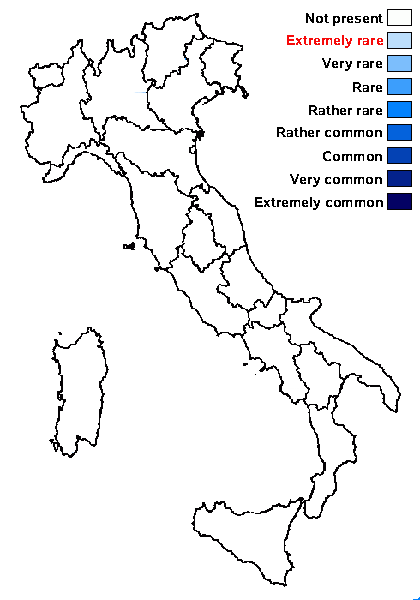Gyalolechia delphinensis (Poelt) Søchting, Frödén & Arup nom. inval.
in Arup & al., Nordic J. Bot., 31, 1: 70, 2013. Basionym: Fulgensia delphinensis Poelt - Mitt. bot. Staatsamml., München, 5: 599, 1965
Synonyms:
Distribution:
Description: Thallus crustose, episubstratic, verrucose-areolate, sulphur- to orange-yellow, forming 1-2(-3) cm wide patches, the areoles contiguous, the marginal ones sometimes slightly elongate, to 1-2 mm long, the central ones strongly convex, almost verrucose, 0.3-0.5 mm thick; schizidia sometimes present. Upper cortex paraplectenchymatous, with an epinecral layer; medulla white; lower cortex absent. Apothecia lecanorine, sessile, 0.5-1.3 mm across, with an orange to brownish orange, flat to slightly convex disc, and a thin margin which at maturity separates into a darker and thinner proper margin and a paler thalline margin. Epithecium orange-brown, K+ purple-red; hymenium and hypothecium colpourless. Asci 8-spored, clavate, functionally unitunicate, apically thickened with a broad internal beak, the inner part of apex and external cap I+ blue, Teloschistes-type. Ascospores 1-septate, not constricted at septum, not polarilocular, hyaline, subfusiform, thin-walled, 19-21 x 5-6 μm. Pycnidia orange-yellow, immersed. Conidia oblong. Photobiont chlorococcoid. Spot tests: thallus and apothecia K+ purple-red, C-, KC-, P-, UV+ pale orange. Chemistry: unknown, but probably similar to that of other closely related species, with fragilin dominant, and smaller amounts of emodin and parietin.Note: a species recalling G. bracteata in habitus, but with 1-septate ascospores; on gypsum soil in the Western Alps (France); to be looked for in the Italian Alps. The combination into Gyalolechia is invalid, as the purported basionym was "Caloplaca delphinensis".
Growth form: Crustose
Substrata: soil, terricolous mosses, and plant debris
Photobiont: green algae other than Trentepohlia
Reproductive strategy: mainly sexual

Predictive model
Growth form: Crustose
Substrata: soil, terricolous mosses, and plant debris
Photobiont: green algae other than Trentepohlia
Reproductive strategy: mainly sexual

Predictive model

